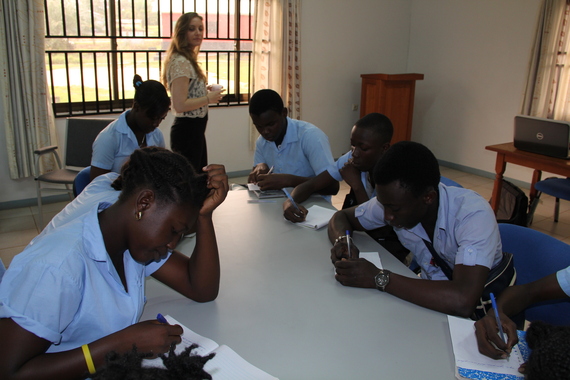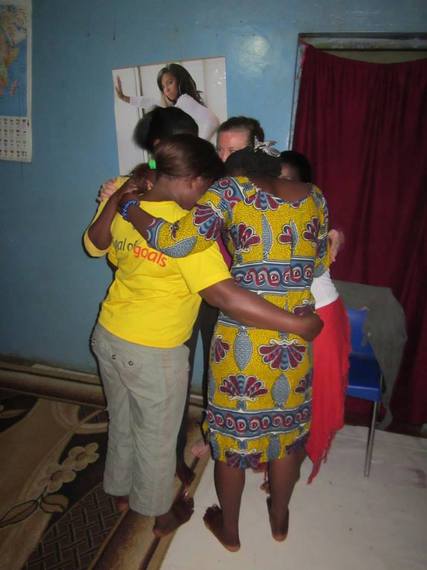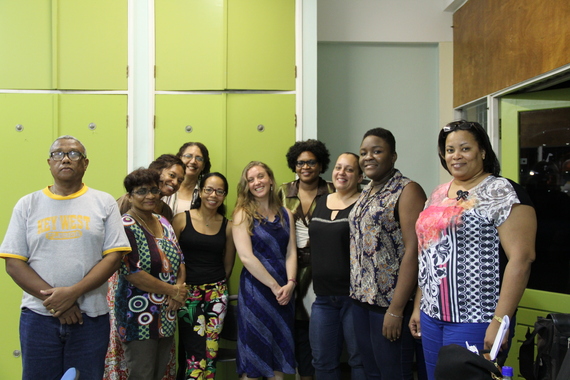One year ago, the United States Government invited me to Suriname through the U.S. Speakers Program in recognition of Women's History Month. I spent a week in that balmy, tiny South American country -- which is nestled above Brazil and between Guyana and French Guiana; where the various East Indian, Javanese, Chinese, Creole, and Maroon populations total at about half a million people; and where the official language, in case you were wondering, is Dutch -- and while there I did two or three events a day with the indispensable help of Virginia and Ingrid from the American Embassy. I talked with former teen prostitutes in a boarding house about making tough memories into skits and poems. I conducted creative writing workshops with high school students in low-income regions of the country. I read Adrienne Rich's "Diving Into The Wreck" to an adult writing group at a reading ho-hosted by Surinamese authors Karin Lachmising and Carry-Ann Tjong Ayong. I read to social workers in Paramaribo from my own book, The Survival Girls, which is about my experience founding a self-sustaining theater group for Congolese Refugee women in a slum of Nairobi, Kenya. The underlying message of my visit, the State Department's initial invitation to me read, was to be the same as that of my work founding the Survival Girls: to assist women and youth in finding their own voices through the empowerment that literary and theater arts can give humans to heal.
The author leading creative writing workshops for high school students in Brokopondo, Suriname (photo credit Virginia Elliot, US Embassy-Paramaribo)
The U.S. Speakers Program, run through the Bureau of International Information Programs, is part of the cultural programming American embassies do around the world to share art and ideas through "people-to-people conversations" between Americans and citizens of other nations, and as it is reserved for "experts in their field, " I was as intimidated as I was honored by the invite. I was 29, and my earlier 20s had largely felt as I'd careened through them like a loosely connected string of sh*t-pearls: facepalm-worthy misjudgements, unbridled and tortured narcissism, Hannah Horvath-style crash-and-burns, punctuated only rarely by the occasional good project abroad. Any time I had attempted something inside America but outside of graduate school, it had imploded: one winter in New York City, looking for a job in publishing in 2008 (ha!) while not wisely avoiding the powerful middle-aged literary men at the center of the industry who went through young women on the side like they went through their glasses of wine; and one winter in Seattle, driving deeper the pain of the New York experience by making the least self-friendly choices -- familial, professional, romantic, substance-related -- in its wake. It was only through traveling to Kenya at the age of 26 after my first year of graduate school, in 2011, and beginning the Survival Girls group with Congolese women who had suffered some of the most hellish abuse imaginable, that the paltry amount I had learned about trauma's effect on my own sense of self built some small bridge to the suffering of other humans. I found myself in Suriname at the invitation of my government because my self-perceived "mistakes" were retroactively given purpose through witnessing the extraordinary courage of the Survival Girls, as they used the space I created with them of consistency and emotional safety to transmute their pain into cathartic and electrifying pieces of original theater about the violence they had suffered. The Survival Girls group has sustained itself for four years because of the plucky, radiant courage and intelligence of the Congolese refugee ladies who are the Survival Girls themselves; it began with a space I only knew how to create because I'd been through enough rocky patches to know what not to do with trauma victims.
Or at least, so I thought, until late in that miraculous week I spent in Suriname in honor of Women's History Month. In something of a crowning event to top off the week, I was to give a public lecture entitled "'Creative Expression as a Tool for Women's Advancement and Equality" on Thursday evening in the University Guesthouse in Paramaribo.

Author giving public lecture on the Survival Girls in Paramaribo, Suriname (photo credit Virginia Elliot, US Embassy-Paramaribo)
The sun was just setting outside, coating the field by the guesthouse in a lavender gold. I had by then met with social workers who'd chatted excitedly after my presentations about ways to bring theater into their school programs with at-risk youth, and laughed with middle school students who responded beautifully to my writing exercise prompt of Jamaica Kincaid's "Girl." Brimming with hope and pride at such a wondrous week, I barreled into my presentation on the Survival Girls, who are personal heroes of mine and whose generous admission into their private lives confirmed what little I had learned about the way trauma works: when they would tell me in private of their most violent memories, the Survival Girls wouldn't just cry. Those who had not been through any therapeutic experience to process the memories -- to literally shift where in the brain those memories were stored -- would "go back there" in the remembrance: a young woman who had seen her mother killed at home in Congo by men who gang-raped her stopped being able to describe the memory, and stopped, for all intents and purposes, being in the room with me as the traumatic flashback robbed her of agency in the present moment and her body reacted as though she was physically back there again.
This is called a limbic hijack, I explained to my audience in Suriname, standing in front of a slide-show of the Survival Girls practicing their play: working with traumatized people is working with people whose sense of self can be stolen at any time by an influx of stress hormones that drastically reduce access to the pre-frontal cortex, to one's own long-term memories, learned systems, letters, numbers. What is our self-identity without access to our long-term, peaceful memories, without access to our wisdom, the things we have learned that enable us to make sense out of letters on a page, out of numbers on a phone, enough for a perfectly smart person to scramble the numbers 9-1-1 in a crisis? I used to be smart, and now I'm not, goes a common traumatized refrain. I'm not a regular person anymore. I'll never be normal.
The second part of my presentation began with the fact that according to recent reports, one in three women the world over has suffered some form of abuse or sexual assault. Out of over three billion women on the planet, that's over a billion women who feel this way. And that's a conservative estimate; the percentage of women violated goes up in developing nations and post-conflict zones. And if the woman is in a war zone, or if she is under the poverty line, or is homeless anywhere, the odds are even worse -- the odds are not just there, but are overwhelming that she has suffered assault. So the odds are also that in the aftermath of the violence she has almost certainly suffered, her interiority is constantly threatened and rent apart by the kind of post-traumatic response I described above wherein stress hormones run the body and brain willy-nilly at the drop of a hat.
But all is not hopeless, I went on to say that evening in Suriname, as my small but attentive audience nodded and took notes. The creative arts, especially theater, can help restore selfhood to those who have lost it to violence and its memory, by providing a catharsis that engages the body as well as the mind, forging new neural pathways through that chosen physical embodiment.
And that's when I made my mistake: I showed a video of the Survival Girls improvising a violent scene (accordingly, a trigger warning applies):
This video is one I took of the Survival Girls' first improvisation of that scene of violation. My audience knew that the Survival Girls had decided to base the piece on one of the Girls' own memories of a rebel soldier violating her and and killing her mother in their home. They audience knew also that the scene was one the Survival Girls had written and cast themselves. Ninety seconds of a shaky tape: the Survival Girls consciously and voluntarily telling the story. I gave a warning that the tape might be hard to watch, but I didn't know how much -- until a woman in the audience raised her hand.
As she faltered, her eyes glassy and her mouth opening and closing without sound, the memory of her rape at the hands of a family member when she was young clouding her vision even as she began to talk about it, I could see the telltale signs of the traumatized condition unfolding in front of me and everyone who looked on at her, illustrating the very phenomenon I'd meant to create awareness of, but not to provoke. I turned off my mike and walked slowly toward her. I crouched alongside her table as she related more of the memory. I kept my voice low and steady, and repeated the same things I had in Kenya: that talking about it was a first step, that it was normal to feel at the mercy of this memory, and that there were things that could help. She had a lovely face, round and dimpled, with dark eyes, and her hair was pulled back into a bun. She was there with two co-workers, who hadn't known she'd suffered this, but who assured me they would be there for her. I thanked her for her bravery. I asked if I could touch her, if I could give her a hug. I mostly remember that she neither stiffened at my hug as though she didn't need it, nor melted into it as though she did, but accepted it graciously, cognizantly, and I believed she would eventually be fine.
I have never before allowed a year to elapse between doing my work abroad and writing about it, but something has kept me from knowing how to enter the realm of description. It has to do with the mistake I made, underestimating how impacting a short video of a conscious and clothed re-enactment of rape would be. A mistake I made by pressing "play" in that guesthouse, in my government-work-friendly outfit with a microphone in my hand. A mistake that has to do with the sacred nature of bearing witness to the suffering of others. I think of her standing there almost daily, telling a room full of strangers in a way she almost certainly hadn't planned on doing that when she was small, she was raped. Standing there in her vulnerability, which is the same, I believe, as standing there in her bravery. Experiencing, as we say in acting workshops, the private act made public, which is the stuff of good performance, and when it is about real life, the stuff of true courage.
I grapple most with the plain fact that for the Survival Girls, and for this woman who was so vulnerable in such a public venue in a way she couldn't altogether control, the most I know about them is the worst thing that happened to them. Their countless talents, their senses of humor, their favorite shows, their favorite foods -- I didn't hear about those as much as I heard about their trauma and pain and shame. How can I do justice to the fact that every traumatized woman in the world is more than what has happened to her, more than the worst memory she has, if that memory is the most of what I know about her, and therefore the most of what I have to tell you about her?
Women's History Month means different things to different people. More and more lately I have ruminated on that age-old literary assignation of "confessional" or "personal" writing as inherently feminine: is there something about knowing that one-in-three women walking around today carries the subjective, personal time bomb of violent memory with her that can help us break through to an understanding of trauma that honors women? After that public lecture, I led a poetry workshop with teens in the border territory of Nickerie on my last day in Suriname. A quiet place, lush green and indirect sunlight dispersed through tropical cloud cover. Our government vehicle wended through the sharply divided forest and sky to a somewhat dirty school ground and a classroom full of Hindustani teens, a demographic that, I was informed in the car on the way over, had seen a recent spike in suicide among adolescent girls being subjected to arranged marriages. I was asked to Suriname in part because transmuting personal pain through the arts was nothing less than a survival strategy those hard-working cultural officers at the American Embassy hoped to impart to young women on the border who felt so alone that dying was the only option they saw out of their pain.
Women's History Month is perhaps best encompassed by the complex sensations and memories that constitute one woman's history -- each distinct woman's history. The pessimistic, or perhaps realist, view of human history is one in which women are taken and violated across cultures and across centuries. Women's history, to me, is largely about a history of violence -- of violation -- and the terribly private yet uncontrollable way its aftermath rends apart the self: that choicelessness continues, salt in the wound of a trauma whose original act occurred in a moment of unspeakable choicelessness on the part of the victim. It continues, in anyone who is laid bare unpredictably by post-traumatic states. I played that video of the Survival Girls because they found forward progress in their own choice to re-enact their memories, in the restoration of agency to themselves. Traumatic memories that go unprocessed, wounds that go unhealed, settle into neural (and, some researchers think, cellular and genetic) patterns, but the brain is a remarkably plastic organ, and other, more nourishing patterns can also take root. One workshop with sex workers I led in Nairobi centered around metaphors for that brighter future: the tree of the mind, the wellspring of the body. Wherever she is, that woman standing so shakily, and therefore so bravely, in the room in Suriname, in my memory -- my Women's History Month is for her, this year. Her history.
And her future.
Author with A Ganar social workers, who specialize in at-risk youth, Paramaribo, Suriname (photo credit Virginia Elliot, US Embassy-Paramaribo)


